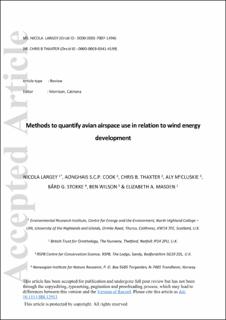| dc.description.abstract | It is likely that there will continue to be a substantial increase in the number of wind turbines as we aim to meet global energy demands through renewable sources. However, these structures can have adverse impacts on airborne wildlife, such as posing a potential collision risk with the turbine structure. A range of methods and technologies have been applied to the collection of bird flight parameters, such as height and speed, to improve the estimation of potential collision compared with traditional visual methods, but these are currently not applied in a consistent and systematic way. To this end, a systematic literature search was conducted to (1) examine the methods and technologies that can be used to provide bird flight data to assess the impact of wind energy developments and (2) provide an updated framework to guide how they might be most usefully applied within the impact assessment process. Four empirical measurement methods were found that improve the estimation of bird flight parameters: radar, telemetry, ornithodolite and LiDAR. These empirical sensor-based tools were typically more often applied in academic peer-reviewed papers than in report-based environmental statements. Where sensor-based tools have been used in the report-based literature, their inconsistent application has resulted in an uncertain regulatory environment for practitioners. Our framework directly incorporates sensor-based methods, together with their limitations and data requirements, from pre-deployment of infrastructure to post-consent monitoring of impacts. This revised approach will help improve the accuracy of estimation of bird flight parameters for ornithological assessment of wind energy. Sensor-based tools may not be the most cost-effective. However, a precedent has been set for wind energy development consent refusal based on ornithological impact assessment, and therefore the cost of collecting accurate and reliable flight data may be balanced favourably against the cost of development consent refusal | en_US |

